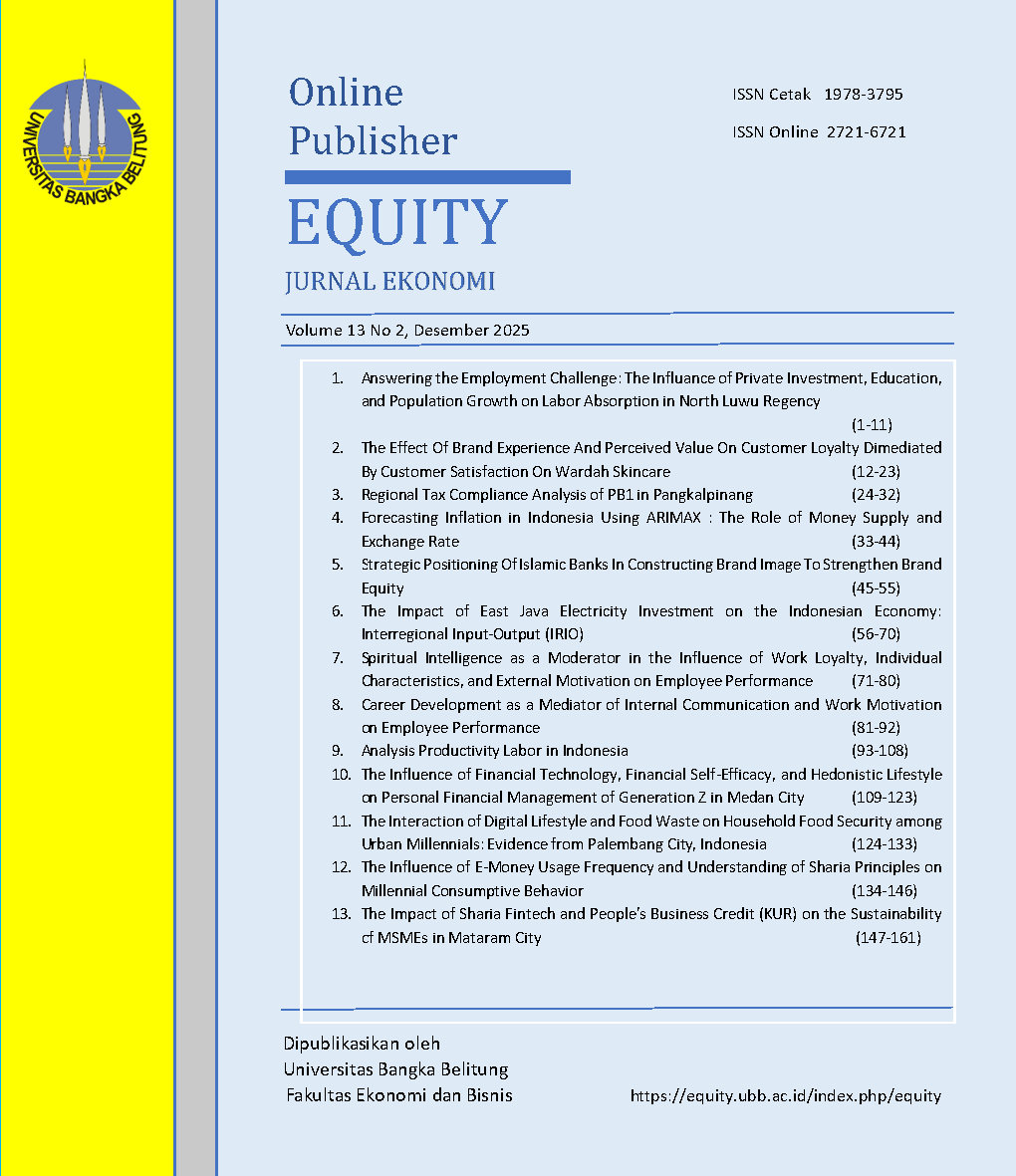Regional Tax Compliance Analysis of PB1 in Pangkalpinang
DOI:
https://doi.org/10.33019/equity.v13i2.398Keywords:
General Taxes, Regional Economy, Government Policy and Regulation, Business Taxes and Subsidies.Abstract
This study aims to evaluate the extent to which the installation of tax banners as media of socialization can improve tax compliance among cafe and restaurant business actors in Pangkalpinang City. Restaurant tax (PB1) is an important contributor to local revenue, with revenue achievements in 2023 amounting to IDR 27.3 billion or 21.7% of total local revenue. This study uses a descriptive qualitative approach, with data collected through observation, interviews, and documentation studies. The research sample includes 1-10 cafe and restaurant owners who have installed tax banners and routinely pay PB1. The research findings indicate that tax banners act as a visual reminder and educational media for consumers, although their influence on business actors is relatively limited. Banners are considered effective in increasing the timeliness of tax reporting, but do not have a significant impact on the amount of tax payments. The SWOT analysis reveals that banners have the advantage of being a cost-effective means of information and physical evidence of compliance, but also have weaknesses such as limited information space and the risk of "banner blindness". This study concludes that the installation of banners has a positive impact on tax compliance, although optimization efforts are still needed through more intensive socialization and periodic policy evaluation. The recommendations put forward include the need for further research with a quantitative approach and expanding the scope of research objects to obtain more comprehensive findings.
Downloads
References
Adawiyah, R., Rahmawati, Y., & Eprianto, I. (2023). Literature Review: Pengaruh Sosialisasi Perpajakan, Sanksi Perpajakan, Pemahaman Peraturan Perpajakan Terhadap Kepatuhan Wajib Pajak. Jurnal Economina, 2(9), 2310–2321. https://doi.org/10.55681/economina.v2i9.812
Badan Pusat Statistik. (2021). Statistik Keuangan Pemerintah Provinsi Dan Kabupaten/Kota Provinsi Kepulauan Bangka Belitung Tahun 2022. Badan Pusat Statistik, 1–603.
Badan Keuangan Daerah Kota Pangkalpinang. (2025). Realisasi Pajak Daerah Tahun 2023, 2024 dan 2025. https://pajakonline.pangkalpinangkota.go.id/
Bobek, D. D., & Hatfield, R. C. (2003). An investigation of the theory of planned behavior and the role of moral obligation in tax compliance. Behavioral research in accounting, 15(1), 13-38.
Dann, D., Müller, R., Werner, A. C., Teubner, T., Mädche, A., & Spengel, C. (2022). How do tax compliance labels impact sharing platform consumers? An empirical study on the interplay of trust, moral, and intention to book. Information Systems and e-Business Management, 20(3), 409-439.
Dayanti, E. O., Arafat, Y., & Valianti, R. M. (2023). Pengaruh Sosialisasi perpajakan, sanksi pajak, dan kualitas pelayanan fiskus terhadap kepatuhan wajib pajak badan usaha restoran (studi pada Dinas Pendapatan Daerah Kota Palembang). Jurnal Media Akuntansi (Mediasi), 6(1), 66-78.
Dewi, W. D. N., & Pravitasari, D. (2022). Pengaruh kualitas Pelayanan, Pemeriksaan Pajak, dan Sanksi Perpajakan terhadap Kepatuhan Wajib Pajak Restoran di Kota Blitar. Jurnal Ekonomi, Pendidikan, dan Akuntansi, 10(1), 37-48.
Febtrina, A., Ahmad, A. W., & Mustika, R. (2022). Pengaruh Pelaksanaan Self Assessment System, Pengetahuan Perpajakan, dan Sanksi Perpajakan Terhadap Kepatuhan Wajib Pajak Restoran di Kota Padang. Jurnal Akuntansi, Bisnis Dan Ekonomi Indonesia (JABEI), 1(1), 15-24.
Gugam, F. M., & Sofianty, D. (2021). Pengaruh Pajak Restoran terhadap Pendapatan Asli Daerah. Prosiding Akuntansi, 1, 2018–2020.
Hurdawaty, R., Wibowo, F. S., & Sulistiyowaty, R. (2023). Studying the consumption behaviour of generations Y and Z towards ready-to-drink coffee. International Journal of Travel, Hospitality and Events, 2(1), 10-26.
Khayati, S. (2021). Tinjauan Hukum Terhadap Kepatuhan Wajib Pajak dalam Membayar Pajak Bumi Dan Bangunan. Arus Jurnal Sosial Dan Humaniora, 1(2), 1–10. https://doi.org/10.57250/ajsh.v1i2.6
Matthew J Salganik, & Douglas D Heckathorn. (2004). Sampling and Estimation in Hidden Populations Using Respondent-Driven Sampling. Sociological Methodology, 34(2004), 193–239. http://www.princeton.edu/~mjs3/salganik_heckathorn04.pdf
Mardiasmo,Perpajakan,Edisi Terbaru 2023, (Yogyakarta:Penerbit Andi, 2023).
Musgrave, R. A. (1959). The Theory of Public Finance: A Study in Public Economy.
Pravasanti Yuwita Ariessa. (2020). Analisis Faktor-Faktor Yang Mempengaruhi Kepatuhan Wajib Pajak Dalam Membayar Pajak Bumi Dan Bangunan. Jurnal Akuntansi Dan Pajak, 21(1), 142–151. https://core.ac.uk/download/pdf/328106991.pdf
Scarpini, C., Santoro, F., & Mascagni, G. (2022). Visual Nudges: How Deterrence and Equity Shape Tax Compliance Attitudes and Behaviour in Rwanda. ICTD Research in Brief, 81.
Setiawan, G. F., & Gayatrie, C. R. (2018). Analisis Efektivitas Dan Kontribusi Pajak Restoran Terhadap Pendapatan Asli Daerah (PAD) Kabupaten Semarang. Jurnal Aktual Akuntansi Keuangan Bisnis Terapan (AKUNBISNIS), 1(2), 127–136. https://doi.org/10.32497/akunbisnis.v1i2.1226
Slemrod, J. (2018). Nber Working Paper Series Tax Compliance and Enforcement. Tax Compliance and Enforcement, 1–99. http://www.nber.org/papers/w24799
Sudiartana, M., & Mendra, N. P. Y. (2018). Taxpayer compliance in SMEs sector: A theory of planned behavior. Jurnal Keuangan dan Perbankan, 22(2), 219-230.
Ubago Martínez, Y., Pascual Arzoz, P., & Zabaleta Arregui, I. (2022). Tax collection efficiency in OECD countries improves via decentralization, simplification, digitalization, and education. Journal of Policy Modeling, 44(2), 298–318. https://doi.org/10.1016/j.jpolmod.2022.03.003
Downloads
Published
Issue
Section
License
Copyright (c) 2025 Pipin Pipin, Rahil Imainul Aprilian, Fardillah Suciati, Irma Elista

This work is licensed under a Creative Commons Attribution 4.0 International License.
Authors who publish journals in Equity: Jurnal Ekonomi agrees with the following conditions:
1. Authors retain copyright and grant the journal right of first publication with the work simultaneously licensed under a Creative Commons Attribution 4.0 International License.
2. Authors are able to enter into separate, additional contractual arrangements for the non-exclusive distribution of the journal's published version of the work (e.g., post it to an institutional repository or publish it in a book), with an acknowledgement of its initial publication in this journal.
3. Every publication (printed/electronic) are open access for educational purposes, research, and library. Other than the aims mentioned above, the editorial board is not responsible for copyright violation.













